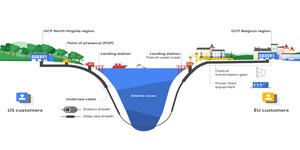
Google has announced that it will be running its entire global operations, from data centres to offices, entirely on renewable energy sources from next year, following the launch of a new wind-powered data centre in the Netherlands.
The environmental cost of computing is not easily dismissed: While processors get more efficient every year, data centres draw a considerable amount of power to serve their users - power used not only for the computers themselves but to deal with cooling the rooms in which they operate. The shift to cloud computing models, where users have lower-power devices like Chromebooks and smartphones and the heavy lifting is done remotely, has done little to resolve this, and it's estimated that data centres alone account for around three percent of global energy usage and rising.
To address this, advertising giant Google has announced an initiative to run its entire global operations solely from renewable energy. 'I’m thrilled to announce that in 2017 Google will reach 100% renewable energy for our global operations — including both our data centres and offices,' explained Google's senior vice president for technical infrastructure Urs Hölzle in the company's announcement. 'To reach this goal we’ll be directly buying enough wind and solar electricity annually to account for every unit of electricity our operations consume, globally. And we're focusing on creating new energy from renewable sources, so we only buy from projects that are funded by our purchases.'
The move to renewable power is something that Google has been working towards for a considerable time, but it's only recently that it has become feasible to do away with fossil-fuel and other traditional power generation systems: the company explained it has seen the cost of wind and solar power generation drop by 60 and 80 percent respectively over the last six years. Naturally, though, Google isn't relying on wind and solar power alone; instead, it's using the usual model of sourcing as much electricity directly from renewable sources as possible then buying 'renewable energy credits' to match whatever it draws from traditional generation.
As proof the model works, Google also announced the opening of a new data centre in Eemshaven which, his company has claimed, is entirely powered from a nearby wind farm in Delfzijl. In total, the company has claimed to be responsible for committing to 2.6GW of renewable energy, making it the largest corporate purchaser globally.
The environmental cost of computing is not easily dismissed: While processors get more efficient every year, data centres draw a considerable amount of power to serve their users - power used not only for the computers themselves but to deal with cooling the rooms in which they operate. The shift to cloud computing models, where users have lower-power devices like Chromebooks and smartphones and the heavy lifting is done remotely, has done little to resolve this, and it's estimated that data centres alone account for around three percent of global energy usage and rising.
To address this, advertising giant Google has announced an initiative to run its entire global operations solely from renewable energy. 'I’m thrilled to announce that in 2017 Google will reach 100% renewable energy for our global operations — including both our data centres and offices,' explained Google's senior vice president for technical infrastructure Urs Hölzle in the company's announcement. 'To reach this goal we’ll be directly buying enough wind and solar electricity annually to account for every unit of electricity our operations consume, globally. And we're focusing on creating new energy from renewable sources, so we only buy from projects that are funded by our purchases.'
The move to renewable power is something that Google has been working towards for a considerable time, but it's only recently that it has become feasible to do away with fossil-fuel and other traditional power generation systems: the company explained it has seen the cost of wind and solar power generation drop by 60 and 80 percent respectively over the last six years. Naturally, though, Google isn't relying on wind and solar power alone; instead, it's using the usual model of sourcing as much electricity directly from renewable sources as possible then buying 'renewable energy credits' to match whatever it draws from traditional generation.
As proof the model works, Google also announced the opening of a new data centre in Eemshaven which, his company has claimed, is entirely powered from a nearby wind farm in Delfzijl. In total, the company has claimed to be responsible for committing to 2.6GW of renewable energy, making it the largest corporate purchaser globally.

MSI MPG Velox 100R Chassis Review
October 14 2021 | 15:04








Want to comment? Please log in.